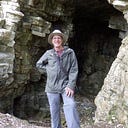Nothingness Makes Sense — When You Include Space in Matter
Almost twenty years now, after a period of intense introspection, I explicitly acknowledged, both to myself and others, the reality of what I call ‘natural inclusion’: the evolutionary process through which all natural material forms come into being and diversify as flow-forms — mutual inclusions of space and energy in receptive-responsive relationship. As a result I felt able to understand in a new way a huge variety of natural phenomena that didn’t make sense to me previously, either in terms of conventional, dualistic science — which treats material and immaterial presences as mutually exclusive opposites — or in terms of self-less nihilism, which dissolves all natural form into boundless oneness.
What I suddenly realized was simply this: nothingness makes sense when you include space in matter, but no thing makes any sense when set apart from space. In other words, matter and space can only be mutually inclusive if the former is to exist in any tangible form. And with that realization, the whole of atomistic logic upon which dualistic science is founded makes no sense, along with the whole notion of boundless oneness.
I wasn’t the first person ever to arrive at this realization. It is evident, at least implicitly, in a wide variety of ancient, modern and indigenous spiritual traditions. Quite possibly it is also evident to many of us as recently born children, even though we wouldn’t know then how to express it in words. I may have been unusual, however, as an adult biological scientist brought up to think in mechanistic and neo-Darwinian terms, to imagine and try to explain how it enables us to understand all kinds of natural evolutionary processes, from sub-atomic to social and galactic scales of organization.
To try to communicate this realization, and why it is so vital to human understanding and flourishing, is, however, no easy task, due to the prevalence of two contrasting modes of thought that differ fundamentally in their perception of nothingness. In the first mode of thought, which roughly corresponds with the ‘Western abstract rationality’ originating in ancient Greece, nothingness is perceived as an absence or empty space that cannot, by definition, exist within matter as ‘something’. This is the root of the binary (‘present or absent/something or nothing/1 or 0/true or false’) logic upon which our conventional definitive treatment of ‘objects’ and ‘gaps’ has been founded and embedded in our mathematics and language of ‘figures and background’, ‘words and spaces’. The very idea of nothingness as a continuously receptive presence of space everywhere is precluded by such thought, and so to speak of it this way, as I do, is to invite either vacant looks or outright disputation.
In the second mode of thought, perceived by Western rationalism as ‘Eastern mysticism’, and enshrined in some, but NOT ALL expressions of Buddhism, nothingness is all there is. This renders self-identity non-existent and all material forms as mere illusory appearances. Such self-less nihilism commonly finds expression in such paradoxical sayings as ‘we’re all one seamless whole’.
Sadly, the effect of these radically alternative modes of thought is to make non-sense of the natural existence of life and love in material form. This renders Nature meaningless and engenders deep psychological, social and environmental distress and needless ideological conflict, of the kind that is all-too-evident in modern culture.
The two opposing views can, however, be brought into complementary and realistic relationship through the ‘middle way’ of the natural inclusion of each in the other, no sooner do we recognise that matter both dynamically includes and is included within the omnipresence of space as a boundless, intangible presence. When we do this, not only do we recognise the receptive-responsive relationship between our natural experience of gravity and electromagnetism that has been obscured by abstract rationality, but we restore the existence of love and life into our material form. We experience gravity as a ‘tug of love’ deep in our receptive hearts, which draws energy lovingly into lively responsive circulation around us, inspiring and buoying us up.
This is the loving-living experience of natural inclusion present in all forms of life as flow-forms — co-creations of space and energy in receptive-responsive relationship. And this is also the loving-living experience denied both by abstract rationality and by self-less nihilism, which dissolves all natural form into the vacancy of boundless oneness instead of dynamically incorporating this vacancy into naturally emerging flow-form.
Thirteen years ago, I expressed my feeling of need for this natural reconciliation between Western and Eastern thought in the painting above and the poem below, which I prepared for a Buddhist friend.
The Holeyness of the Wood — West and East
Two, world’s apart
Whose place is together
In common circumference
Of World spinning Story
One, the proud Standard-Bearer
Of light within darkness
An illumination
Of rectangularity
Held stiffly erect
With All in Order
The Other, a haphazard glimmering
Of darkness in light
A chaotic turbulence
Of fluid movement
Of Order in All
Wherein can be found meaning
Of vital significance
A Communion of holes
Each seeking relief
Obscured by the clutter
Of everyday Strife
Can we feel those holes
At the heart of souls
Or, must we make Shutters
To freeze the moment
Of objective vision?
